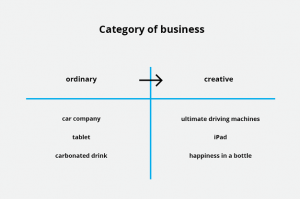Ngày đăng: 02/06/2020
Different brands have different positioning statements, but when analyzing most of them, we can notice some similarities and come up with a most common formula:

Below, let’s break down and clarify these components:

First, you need to understand who your customers are – this is the step to identify target audience. Ask questions Who your customers are, describe their demographics and psychology. Demographics are all that marketers always mention: gender, income, age. Psychology is completely different and more valuable to designers and brand strategists.
Start with demographics, then opinions, activities, interests and all other behavioral characteristics. You need to find out who your target audience is and create user profiles. Finally, define them as succinctly as possible – in a short sentence or just a few words.

Describe your business type, industry, but in a more unique and creative way. Like BMW with the slogan: The ultimate driving machine. From here, BMW can be understood as a car company, or the engineers of these top-notch machines.
The iPad is a tablet but has been positioned in a different way so that it is never described as a tablet. So you need to be creative and should refer to other brand slogans for inspiration. However, the slogan will not directly inspire positioning statements and vice versa, but it will give you certain insights.
After talking about categories, we will describe what helps distinguish you from competitors in the same industry.

Point of difference relates to the elements of the product or service that sets the differentiation. Qualitative and quantitative research will show this point. Think about what your customers will value positively and they may not find it at another competitive brand. Others describe it as a Unique Selling Proposition (USP).

Point out what is most emotional and intangible that your brand or product can create for the target audience. Remember that features are not benefits. Refer to the brand ladder model to see the difference between features and benefits.
An ultimate benefit is the advantage that consumer receives from a product. Another way to study it is to answer the question: What’s in it for me? You should go back to the beginning and do this first because it is difficult to offer attractive final benefits without understanding the product or service features. The ultimate benefit of Coca-Cola is happiness, and Harleys is freedom – those are great ultimate benefits.
Once we have all of the above, the last thing to do is to state why they (the target audience) should believe your affirmation.

The reason to believe must originate from the truth about a specific product or brand and its differentiation. Ask yourself: What are the tangible characteristics of your brand or product feature? Then look at these details and create a solid reason for customers to trust them. You must lay the groundwork for these reasons in qualitative and quantitative studies. For example, you could say: because we have X years of experience, we are determined to Z.
Source: ebaqdesign.com